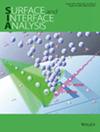Deposition order and physicochemical process visualization of ink intersections using X‐ray photoelectron spectroscopy imaging for forensic analysis
IF 1.8
4区 化学
Q4 CHEMISTRY, PHYSICAL
引用次数: 0
Abstract
The physicochemical events at ink intersections are largely understudied. Chemical imaging techniques and multivariate analyses applied to this problem thus far lack the performance characteristics to make confident conclusions about these processes. This deficiency leads to subjective and controversial deposition order determinations in forensic investigations. In this comprehensive report, 44 unique crossings involving laser toners and stamps, as well as felt‐tip, rollerball, gel, and ballpoint pen inks, were imaged with X‐ray photoelectron spectroscopy (XPS), using a 50‐μm X‐ray spot size and 100‐μm steps. The specificity and surface sensitivity of XPS enabled the objective visualization of the inks' chemistry upon deposition via spatial elemental distribution in‐situ. Signal intensity and atomic concentration were mapped for each element detected. Discrimination was possible in 100% of written and printed inks analyzed, and the relationship between the elemental concentration profile in each intersection was compared with the known sequence. Formation of ink layers, mixing, and separation of ink components by way of electrostatic forces were observed. Insights into the known complexity of ink intersection processes were revealed and highlight the need for understanding the chosen analytical technique's information depth and for complementary analyses to increase sequencing confidence. We also provide evidence that these processes invalidate the utility of principal component analysis for analyzing ink intersections. However, sequencing accuracy was 84% for all samples analyzed, and its success was highly dependent on the presence of physical features (i.e., thick coatings and embossed regions). In some intersection types, especially toners, the features exposed with XPS imaging enabled a sequencing accuracy of 100%.用于法医分析的X射线光电子能谱成像墨水交叉点的沉积顺序和物理化学过程可视化
油墨相交处的物理化学事件在很大程度上没有得到充分的研究。迄今为止,用于该问题的化学成像技术和多变量分析缺乏性能特征,无法对这些过程做出自信的结论。这一缺陷导致了法医调查中主观和有争议的取证令决定。在这份综合报告中,使用50 μm X射线光电子能谱(XPS)和100 μm步长,对44个独特的交叉点进行了成像,这些交叉点涉及激光碳粉和印章,以及毡尖、滚球、凝胶和圆珠笔墨水。XPS的特异性和表面灵敏度使得通过元素在原位的空间分布来客观地观察油墨在沉积过程中的化学性质。对检测到的每种元素绘制信号强度和原子浓度图。所分析的100%的书写和印刷油墨都可以识别,并将每个交叉点的元素浓度曲线与已知序列之间的关系进行比较。观察了静电作用下油墨层的形成、油墨组分的混合和分离。洞察到已知的油墨相交过程的复杂性被揭示,并强调需要了解所选择的分析技术的信息深度和补充分析,以增加测序的信心。我们还提供证据表明,这些过程使主成分分析用于分析油墨相交的效用无效。然而,所有分析样品的测序精度为84%,其成功高度依赖于物理特征的存在(即厚涂层和压纹区域)。在某些交叉类型中,特别是碳粉,XPS成像暴露的特征使测序精度达到100%。
本文章由计算机程序翻译,如有差异,请以英文原文为准。
求助全文
约1分钟内获得全文
求助全文
来源期刊

Surface and Interface Analysis
化学-物理化学
CiteScore
3.30
自引率
5.90%
发文量
130
审稿时长
4.4 months
期刊介绍:
Surface and Interface Analysis is devoted to the publication of papers dealing with the development and application of techniques for the characterization of surfaces, interfaces and thin films. Papers dealing with standardization and quantification are particularly welcome, and also those which deal with the application of these techniques to industrial problems. Papers dealing with the purely theoretical aspects of the technique will also be considered. Review articles will be published; prior consultation with one of the Editors is advised in these cases. Papers must clearly be of scientific value in the field and will be submitted to two independent referees. Contributions must be in English and must not have been published elsewhere, and authors must agree not to communicate the same material for publication to any other journal. Authors are invited to submit their papers for publication to John Watts (UK only), Jose Sanz (Rest of Europe), John T. Grant (all non-European countries, except Japan) or R. Shimizu (Japan only).
 求助内容:
求助内容: 应助结果提醒方式:
应助结果提醒方式:


